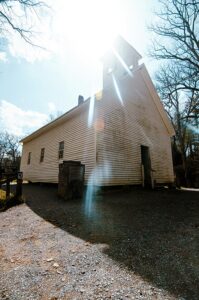Life in rural Appalachia may be receiving more attention than usual lately. Yes, the author of an Appalachian-upbringing memoir, J.D. Vance, is, as of this writing, running for vice president on the Republican presidential ticket, causing many who hadn’t yet read (or watched the 2020 Netflix film based on) his Hillbilly Elegy to do so.
But the region has been in the news for other reasons too. In late September, hurricane-fueled floods decimated a swath of Southern Appalachia known for its steep ravines and river-valley towns. Key roads running alongside and across streams were lost to flood waters — as were homes, cars, and more than 200 lives.
All this in a region that already lags behind the rest of the nation on a number of socioeconomic indicators, according to the Appalachian Regional Commission. The authors of Hillbilly Elegy and of What You Are Getting Wrong About Appalachia, Vance and Elizabeth Catte respectively, might sharply disagree on the root causes of these economic disparities. But a new batch of books is focused on answering a different question: How is the church in Appalachia? How is Appalachia faring spiritually?
It’s a question that might interest even casual readers of Appalachian literature. After reading Barbara Kingsolver’s Demon Copperhead, followed not long after by Jeannette Walls’ The Glass Castle, I too had begun to wonder whether the problematic faith traditions reported in their pages were still accurate portrayals. And how did certain beliefs get a foothold in these mountainous regions, known for being both culturally united and geographically dispersed?
Wake Forest University Divinity School professor Bill J. Leonard explores many of these themes in his new book, Appalachian Mountain Christianity: The Spirituality of Otherness, which is out in November 2024. To examine core beliefs of Appalachian churches, Leonard focused on two “native mountain” denominations, or those that do not exist outside the region: Primitive Baptist Universalists and Pentecostal Serpent Handlers. Here, Leonard uses the term “otherness” somewhat paradoxically. The book is rife with anecdotes from Appalachia’s storied religious landscape that will resonate with churchgoers from other regions too. The watering down and vanishing of these deeply rooted faith traditions, Leonard argues, is not something to cheer in favor of uniformity and understandability. These traditions, rather, represent a subject worthy of further study.
Other recent books focus less on the history of religious traditions in rural areas and more on how to fuel the flourishing of Christianity in the region today. Ronnie Martin and Donnie Griggs wrote Pastoring Small Towns (April 2023) to encourage pastors just like them. Griggs leads a church he planted in the small town of Morehead City, North Carolina, where he also grew up. Martin was a recording artist before founding a church in Ashland, Ohio, and he is a director for a Kentucky church planting collective called Harbor Network.
 Both men write of their contagious compassion for the towns and congregations where they serve — and of the hard work of staying faithful when the fields feel barren. “Is what I’m doing in the middle of nowhere even worth doing?” Martin asks in the introduction to the book. Its pages respond with a resounding yes, offering spades of encouragement and companionship for others working in the trenches of rural congregations. Scripture, the book proves, is rich with reassurance for the hidden work of rural pastors.
Both men write of their contagious compassion for the towns and congregations where they serve — and of the hard work of staying faithful when the fields feel barren. “Is what I’m doing in the middle of nowhere even worth doing?” Martin asks in the introduction to the book. Its pages respond with a resounding yes, offering spades of encouragement and companionship for others working in the trenches of rural congregations. Scripture, the book proves, is rich with reassurance for the hidden work of rural pastors.
The Gift of Small: Embracing Your Church’s Vocation (October 2024) by Allen T. Stanton also aims to help pastors of small congregations to continue investing in the good work of spiritual, if not numeric, growth. The book follows a strong lineage of others focused on encouraging small churches to remain faithful.
Studies by a Southern Baptist-affiliated research firm, Lifeway Research, have found that seven out of 10 churches have 100 or fewer weekly worship service attendees. Twenty years before, congregations of 100 or fewer represented less than half of all American churches; by 2021, those smaller churches comprised 65 percent of congregations.
In his book De-sizing the Church: How Church Growth Became a Science, Then an Obsession, and What’s Next (April 2024), Karl Vaters explains from 40 years of small-church experience how this shift in scale can be good. Reframing the way we measure fruitfulness in the local church, “through de-sized lenses,” can help the church return to a more biblical view of faithfulness.
As The Gospel Coalition’s Collin Hansen wrote in the foreword to Pastoring Small Towns: When ministering in smaller spaces, “you’ll be forced to rely on Christ alone for your validation.” Put that way, ministry in small towns and churches “is a special gift.”





